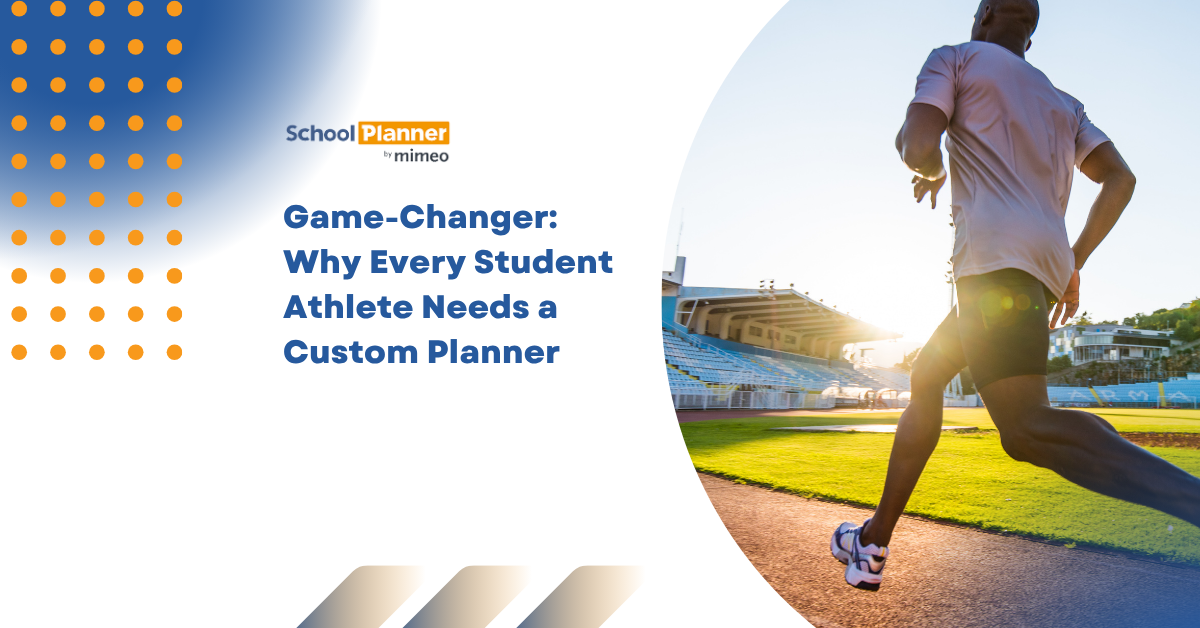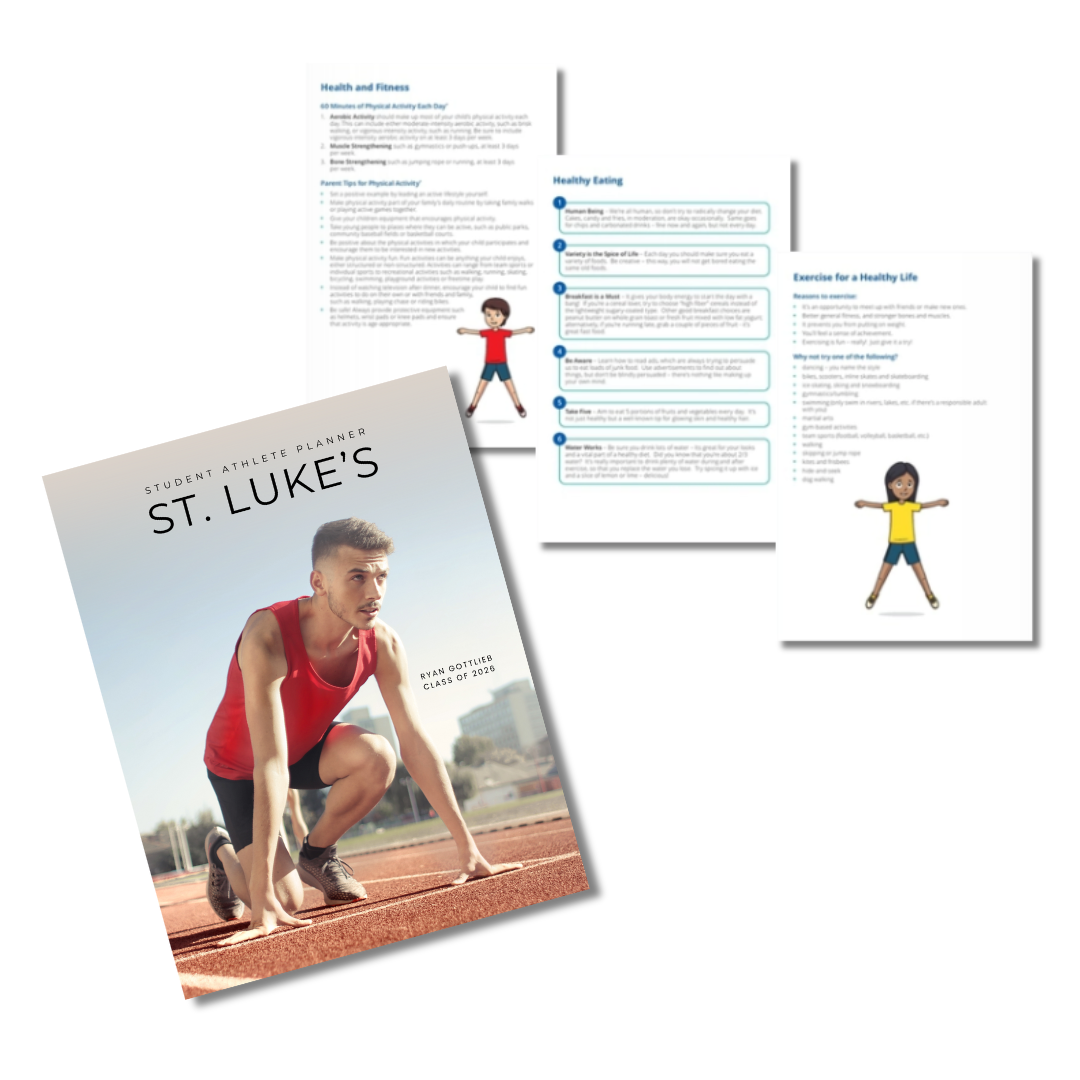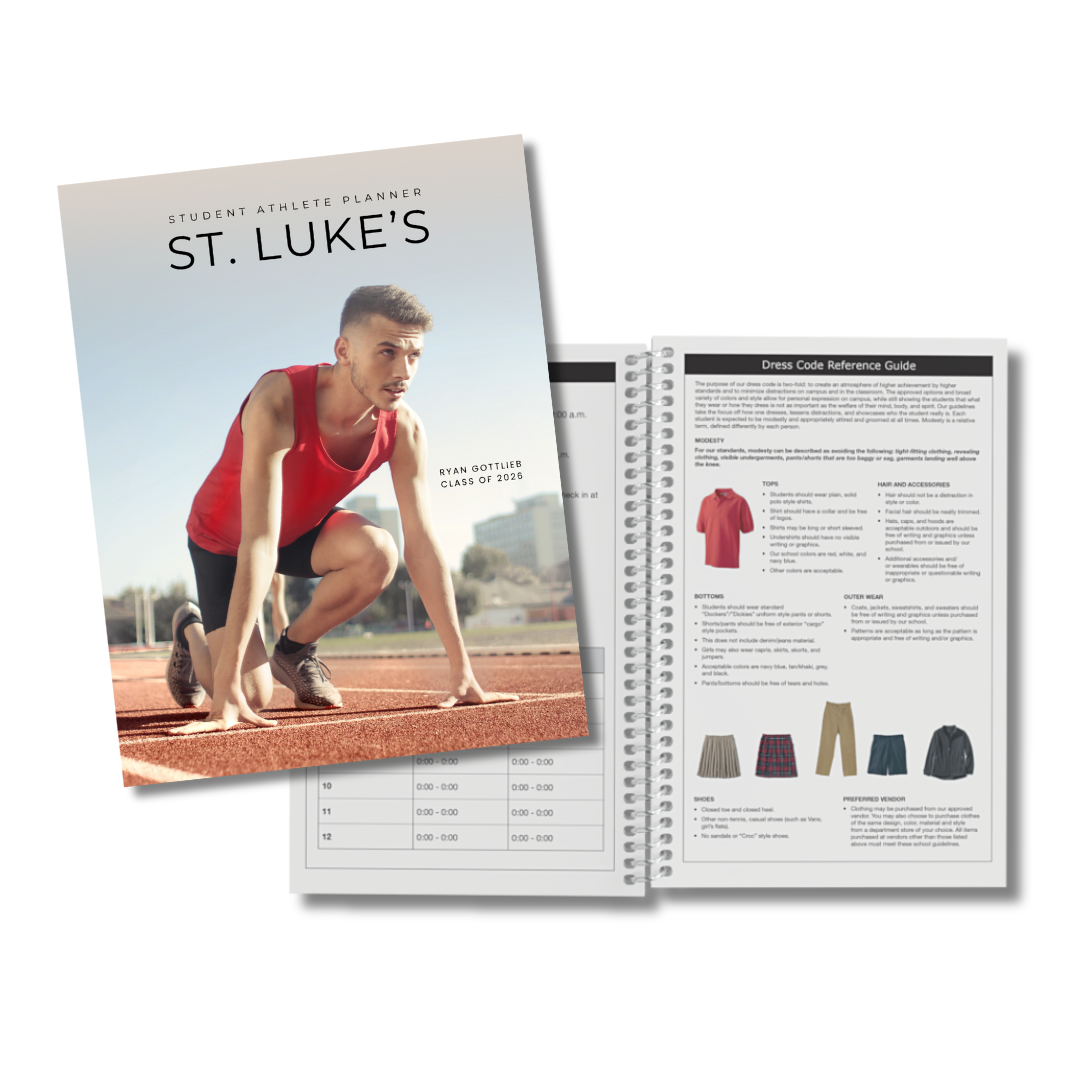
Being a student athlete isn’t just a commitment; it’s a lifestyle. Balancing rigorous academic demands with daily practices, team travel, workouts, recovery, and personal life requires serious organization. Without the right tools, it’s easy to become overwhelmed, burned out, or to fall behind in school or sports. That’s where custom student athlete planners come in.
More than just notebooks with dates, custom student planners are intentionally designed to help student athletes stay on track, motivated, and performing at their best both on and off the field.
If you’re looking for a way to help athletes feel connected, consider custom planners as a game-changing resource designed specifically to support student athletes in staying organized, focused, and mentally strong all year long.
Table of Contents
Why Student Athlete Planners?
1. Built for the Dual Life
Student athletes juggle two full-time jobs: school and sports. A regular planner just doesn’t cut it. Custom planners offer tailored layouts that include:
- Class schedules & homework trackers
- Practice & game logs
- Workout and conditioning logs
- Nutrition & hydration trackers
- Sleep & recovery check-ins
- Goal-setting pages (both athletic and academic)
2. Time Management = Peak Performance
Time is one of the most valuable (and limited) resources for a student athlete. A customized planner helps them:
- Map out their week with intentionality
- Prepare for peak performance periods
- Avoid last-minute scrambling for assignments or team meetings
- Track progress and reflect regularly
3. Built-In Accountability
Whether it’s tracking protein intake, logging hours of sleep, or recording daily gratitude, the planner becomes a quiet coach. It holds athletes accountable to their routines, goals, and personal development.

What makes a great student athlete planner?
Not all planners are created equal. The best custom planners for student athletes include:
- Durable, athletic-friendly design (Think spiral-bound, waterproof covers, portable sizes)
- Sport-specific templates (Great for football, volleyball, track, etc.)
- Mental health check-ins
- Daily motivation or affirmations
- Space for journaling or reflection
And of course, custom branding for schools, teams, or individual athletes makes it truly personal.
How a Custom Planner Helps Student Athletes Excel
Let’s break down the benefits even more clearly:
Time Management Skills for Life
Student athletes develop time management out of necessity. A custom planner reinforces that habit and builds long-term executive function skills.
Mental Clarity and Focus
Writing things down reduces stress, increases memory retention, and helps athletes feel more in control—even during the busiest seasons.
Improved Academic Performance
When students plan their study time around practices and games, they’re more likely to stay on top of their assignments and avoid last-minute cramming.
Peak Athletic Performance
Tracking nutrition, hydration, workouts, and sleep helps athletes identify what works for their bodies and make informed decisions.
Enhanced Self-Reflection & Motivation
Journaling progress and seeing how far they’ve come can boost morale, build resilience, and remind athletes of their “why” during hard days.
Digital vs. Paper: Why Tangible Planners Still Win
In a world dominated by apps and screens, some may wonder if a paper planner is still relevant. But research shows that writing things down by hand actually improves memory, enhances focus, and leads to better follow-through.
For student athletes, who already spend a lot of time in front of screens, having a tangible, distraction-free planner offers a much-needed break and a more intentional planning experience. It becomes part of their routine—something they can carry in their backpack, locker, or gym bag, always ready for a quick check or update.
Custom student athlete planners often include goal-setting pages for both short-term and long-term aspirations. This isn’t just fluff—it’s a critical performance tool. Whether it’s shaving a second off a sprint time, maintaining a 3.5 GPA, or hitting a new lifting PR, clearly defined goals help athletes stay motivated and focused. By breaking big goals into manageable steps, athletes can track progress over time, adjust their strategies, and celebrate small wins along the way. The best part? It creates a mindset of growth that transcends the sport itself.
How Coaches Can Use Planners as Development Tools
For coaches, these planners are more than an organizational aid—they’re an athlete development tool. Encouraging athletes to log practice intensity, meals, sleep hours, and reflections gives coaches deeper insight into an athlete’s habits, struggles, and mindset.
It can also foster better communication between coaches and athletes, creating a shared language around preparation and accountability. Some teams even implement “planner check-ins” as part of their routine, helping athletes reflect on their performance and set intentions for the week ahead.
Supporting Academic Eligibility and Compliance
Maintaining academic eligibility is a non-negotiable part of being a student athlete, especially for those aiming for college athletics or scholarships. A custom planner helps athletes track grades, assignment deadlines, and GPA progress, making it easier to stay compliant with school or NCAA eligibility rules. Coaches, counselors, and parents can also use the planner as a checkpoint, ensuring that nothing falls through the cracks academically—especially during demanding competition seasons.
Habits That Last Beyond Sports
Perhaps the greatest value of a student athlete planner is that it builds life-long habits. Time management, goal setting, self-awareness, and personal accountability don’t just help athletes win games—they help them succeed in college, careers, and personal life. When an athlete graduates, the structure and skills they’ve built through consistent planner use will continue to serve them—whether they’re preparing for a job interview, managing college coursework, or leading a team in the workplace.
Tracking Student Athlete Success: Key Reports & Data Sources
| Title / Study | Key Findings / Data Highlights | Usefulness for Combined Academic + Athletic + Goal Setting Tracking |
|---|---|---|
| NCAA Division I Academic Progress Rate (APR) Reports | The four-year national APR average for Division I teams has held steady (≈ 984 in recent reports). Sport-level APRs: baseball ~ 978, football ~ 963, men’s basketball ~ 968, women’s basketball ~ 981. Athletic Business+2Athletic Business+2 | Good benchmark data for whole-team academic progress. Could use APR values over time as one line series in a chart. |
| “The Effects of Goal Setting on Sports Performance of Competitive Athletes” (BYU Meta-Analysis, 2025) | Found a moderate positive effect of goal setting on athletic performance (effect size d ≈ 0.38). Short-term goals and combinations of short & long-term goals performed better than long-term alone. Specific/difficult goals + feedback + personalization help. BYU ScholarsArchive | Useful for designing the “goal achievement” series in your chart. Can help set realistic expectations of how goal setting correlates with performance outcomes. |
| Examining Classroom Learning Behaviors, Academic & Athletic Motivation in Collegiate Athletes | Explored how academic motivation, athletic motivation, and learning styles relate in student athletes. Suggests that motivation is an important link between athletic participation and academic success. KU Journals | Can help inform what kind of goal-setting (intrinsic vs extrinsic) or motivational tracking to include in your chart. Maybe include motivation scores or survey responses as a metric. |
| Reexamining Student-Athlete GPA: Traditional vs. Athletic Variables | Study of ~674 first-year student-athletes: traditional predictors (HS GPA, standardized test scores, etc.) had strong correlation with first-year GPA. Athletic variables (playing time, team success) had smaller but non-negligible effects. KU Journals | Helpful to understand what athletic data points might move in tandem with academic data. Could include athletic variables alongside academic in a multi-series chart. |
| Student Athlete Resource Center (SARC) Data Report (2021-23, CSUS) | Term GPAs (~3.0+), APR scores improved (952 → 966), graduation success rates (~83%), high percentages in good standing, etc. Sacramento State | Real example of tracking academic performance, retention, eligibility, and support services over time. Great source to model your chart after because they include both academic metrics and institutional support/outcome metrics. |
Student Athlete Success FAQs
Who are custom athletic planners for?
• High school & college athletes looking to boost productivity
• Coaches who want to equip their teams with mindset tools
• Parents supporting their student athlete’s organization and well-being
• Athletic departments seeking a unique and practical gift
How can student-athletes balance academics with their sports commitments?
Planning is key. Using tools like planners or digital calendars to schedule study blocks around practices and games helps keep academics on track. Communicating early with professors about travel or competition schedules is also essential.
Do student-athletes receive academic support?
Many schools offer tutoring, study halls, and academic advisors specifically for student-athletes. These resources help ensure athletes meet graduation and eligibility requirements.
What GPA do student-athletes need to maintain?
Requirements vary by school and league. For example, NCAA Division I athletes must meet minimum GPA and credit-hour benchmarks each semester to remain eligible. High school athletes often must maintain at least a 2.0 GPA, but standards differ by district.
How much time do student-athletes spend on their sport each week?
It varies by level. High school athletes may spend 10–15 hours weekly, while college athletes can spend 20+ hours on practices, travel, strength training, and games.
How are athletic goals tracked and measured?
Goals can be set for individual performance (e.g., times, stats, fitness benchmarks) and team success. Regular check-ins with coaches, data tracking, and goal-setting tools help measure progress.
How can student-athletes manage their time effectively?
Time-blocking, setting clear priorities, and using planners or apps are effective strategies. Many successful student-athletes treat academics like scheduled “practice time,” ensuring both areas receive dedicated attention.
What mental health resources are available for student-athletes?
Most schools have counseling centers, mental wellness programs, or access to sports psychologists. Coaches and academic advisors can connect students with appropriate support.
What is academic eligibility, and why does it matter?
Academic eligibility ensures student-athletes meet the minimum standards to participate in sports. Falling below GPA or credit requirements can result in suspension from competition.
Can student-athletes lose their scholarship if their grades drop?
Yes, at the college level, athletic scholarships often depend on maintaining academic and team eligibility. Each institution has specific policies.

Ready to Design Yours? Request a Free Quote Today.
Whether you’re an individual athlete, a coach ordering for your team, or a school looking for branded planners, we offer full customization to match your goals and identity.
- Custom covers
- Layouts for mindset & focus
- Progress tracking tools
- Team colors & logos
Your schedule is packed. Your goals are big. Let’s build a planner that keeps up.